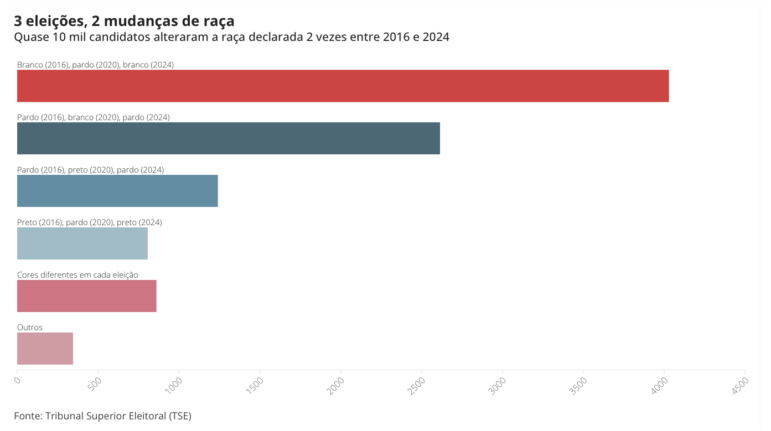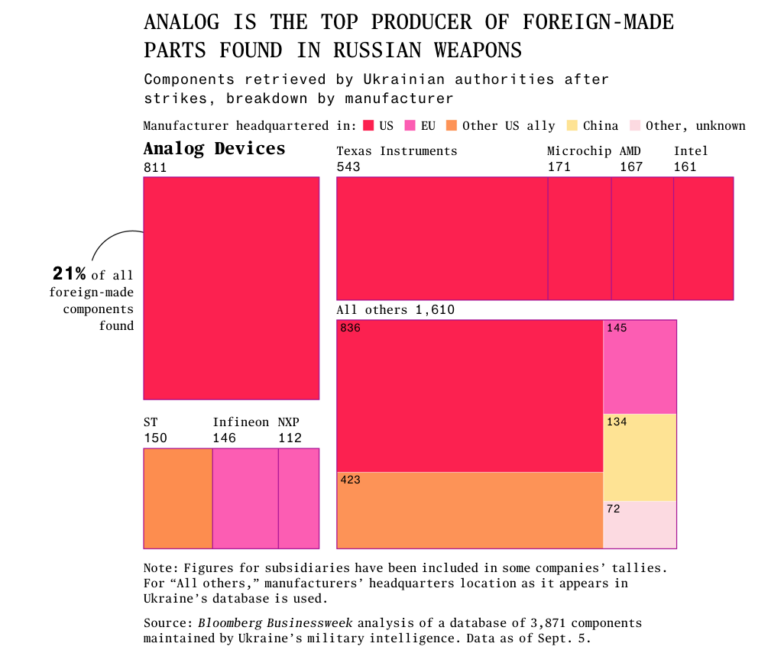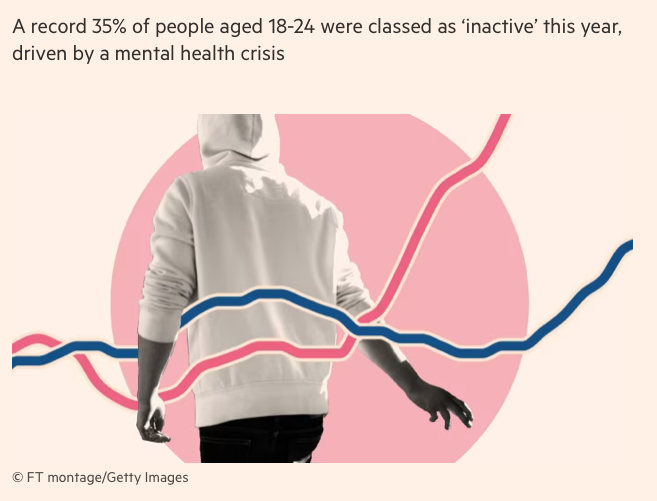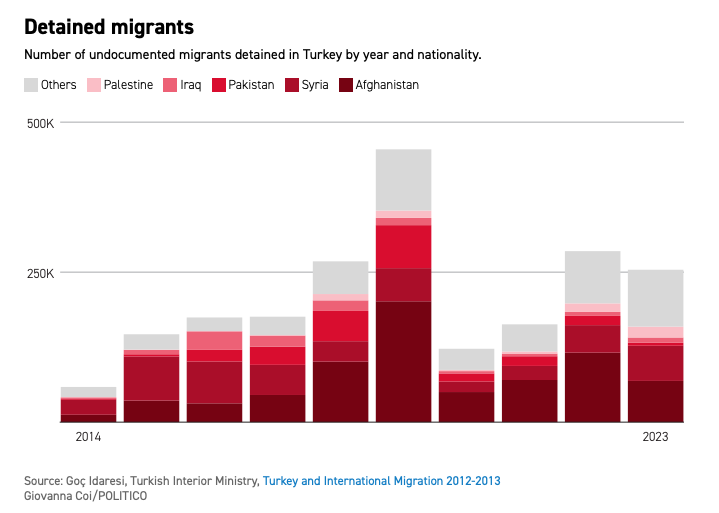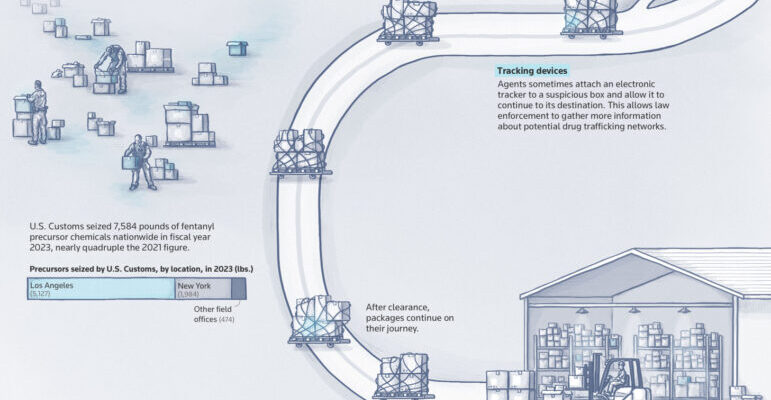
Less than a week before the first anniversary of the conflict between Israel and Hamas in the Gaza Strip, Israeli troops began a new offensive, advancing on land through Lebanese territory. In an interactive special on the destruction in Gaza over the past 12 months, The Washington Post explained that the strip may require 80 years to rebuild. Following the destruction from Hurricane Helene a few weeks ago — and ahead of Hurricane Milton two weeks later — The New York Times reflected on migration to natural disaster-prone regions in the United States, and which disasters are expected to intensify with climate change. This edition of our Top 10 in Data Journalism, which considered stories between September 30 and October 13, also highlights a Nikkei analysis on how changes in fish species in Japan could affect the future of Japanese cuisine; a Reuters investigation on the clandestine fentanyl route from Mexico to China; a La Data Cuenta analysis of female winners of the Nobel Prize for Literature; and a touching tribute from the South China Morning Post to a late designer on its infographics team.
State of Gaza After One Year of War
October 7 marked one year of Israel’s offensive in the Gaza Strip, launched in response to the Hamas attack that left around 1,140 dead and around 250 people taken hostage. The scale of the destruction in this conflict is unprecedented, according to the United Nations. In addition to the more than 42,000 deaths reported by Palestinian authorities, the UN estimates that Israeli bombings and airstrikes have damaged more than 65% of the structures in Gaza, and nearly two million Palestinians remain displaced. In this beautifully illustrated guide, The Washington Post discussed the extent of the destruction caused by a year of conflict and the three phases of a possible reconstruction of Gaza, according to experts. The first phase would consist of meeting immediate humanitarian needs. The second phase would be dedicated to clearing the rubble, which is estimated to be more than 45 million tons, as well as removing tens of thousands of unexploded munitions and what is estimated to be more than 10,000 bodies from the debris. Finally, the third phase would focus on the reconstruction of the buildings and infrastructure of the Gaza Strip, which could be hampered by Israel’s tight control of the borders of the Palestinian territory and, according to the UN, could take up to 80 years.
Mapping Disaster-Prone Areas in the United States
Another topic widely covered by data journalism teams around the world is the hurricanes that have recently hit North America, from analyses of the destruction caused by Hurricane Helene, which left more than 250 people dead, to countless live trackers and projections of the possible devastating consequences that could occur during the passage of Hurricane Milton — and which, fortunately, did not come to pass. Between the passage of the two storms, The New York Times created a map of US counties that have been some of the most popular places to move to — that also happen to be very prone to natural disasters. These regions are regularly hit by hurricanes, for instance, Florida — which gained millions of new residents between 2000 and 2023 — or face major forest fires and floods or suffer from scorching heat. According to the report, while many northern locations and expensive coastal cities such as Los Angeles and San Francisco lost residents in the same period, California’s wildfire-prone Sierra Nevada region saw an influx of people, as did Phoenix, Arizona, which has not only been one of the fastest-growing cities in the country for years but also one of the hottest — this year alone it recorded 100 straight days with temperatures above 100 degrees Fahrenheit (38 degrees Celsius).
The Changing (Declared) Race of Brazilian Political Candidates
On October 6, municipal elections were held in Brazil as mayors and city councilors were elected across the nation’s more than 5,000 municipalities. Thanks to the country’s electronic voting system, the elected candidates were announced on the same day, and many analyses of the results were published the following day, indicating a strong advance by centrist parties. However, even before Brazilians went to the polls, some curious facts had already come to light, such as a phenomenon highlighted by G1 in this report: almost 10,000 candidates who had changed their race declaration between the 2016 and 2020 elections changed their race again for the 2024 election. In Brazil, the candidate is responsible for declaring their race when registering. According to the report, the most common change was among candidates who initially declared themselves white eight years ago, then Black in the following election, and then white again this year. As a possible explanation, G1 pointed out that the color or race of candidates is one of the criteria used to define the distribution of public money to parties and that, coincidentally, the obligation to transfer at least half of this money to black candidates was trimmed to 30% for the 2024 vote.
How Climate Change Could Change Japanese Cuisine
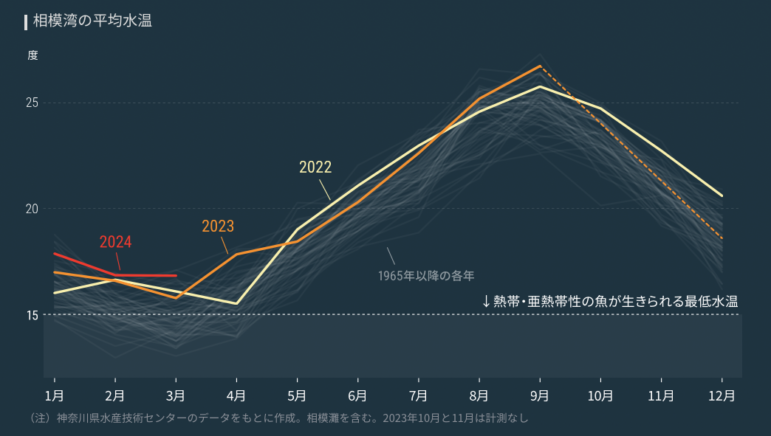
Chart tracking average water temperature (in Celsius) in Sagami Bay, month over month. Image: Screenshot, Nikkei
In this interactive special, Japanese media organization Nikkei analyzed changes in fish species in central Japan’s Sagami Bay over the past century, how these changes relate to global warming, and how this could even affect the future of Japanese cuisine. According to the report, the region has long been the subject of research due to its diversity — approximately 2,000 species, representing 40% of all fish species in Japan, inhabit an area that represents just 0.5% of the country’s territorial waters. These species include both summer and winter fish. However, studies have shown that the number of tropical fish species has increased rapidly in recent years, including in winter. This could be explained, according to Nikkei, by the increase in the average water temperature in the bay. The outlet also highlighted that some species have been moving to colder waters to the north, as well as changes in the weight of fish. Although the average size of fish has decreased, the prices for approximately 60% of them have increased. According to Nikkei, this could be reflected on the tables of the Japanese population in the future, as ingredients for traditional fish dishes may not be available, causing food culture to change drastically.
How Fentanyl Gets from China to Mexico
In this visual explainer, Reuters traced a secret route drug traffickers are using to transport chemicals that produce fentanyl from China to Mexico — via the US. To do this, criminals take advantage of the nearly four million packages of cheap goods imported from China to the US every day, hiding the ingredients that produce fentanyl in small boxes that look like ordinary e-commerce packages. According to Reuters, “the idea is to hide these boxes in plain sight,” lost in the mass of packages that US authorities are unable to check. The next step is to get the materials to Mexico, first using traditional carriers to take the boxes to addresses near the border and then using independent delivery drivers to cross to the other side. To produce the investigation, Reuters spoke to more than 30 current and former US Customs officials, counter-narcotics agents, package delivery veterans, and other trade experts. They also visited a US Customs facility near Los Angeles International Airport, where authorities are hoping to use technology such as artificial intelligence and drug-sniffing dogs to help identify these contraband items.
Russian Missiles with Sanctioned US Chips
Since Russia invaded Ukraine in February 2022, the United States and its allies — in an effort to cripple its defense industry — have imposed a series of sanctions on the country, including a ban on shipments of a wide range of technology. These efforts have not been effective, as this Bloomberg investigation into a cruise missile attack that hit Chernihiv on August 19, 2023 points out. Until that point, the city in northern Ukraine had not seen any fighting for more than a year. According to the report, Ukrainian investigators who recovered parts of the missile were able to confirm that navigation components found among the wreckage in Chernihiv were made by a US chipmaker, and that markings on the engine of the missile that killed seven people — including a six-year-old — and injured 214 others showed that it was assembled no earlier than March 2023, roughly a year after the start of the war and sanctions.
Many Nobel Prizes in Literature, Few Women Winners
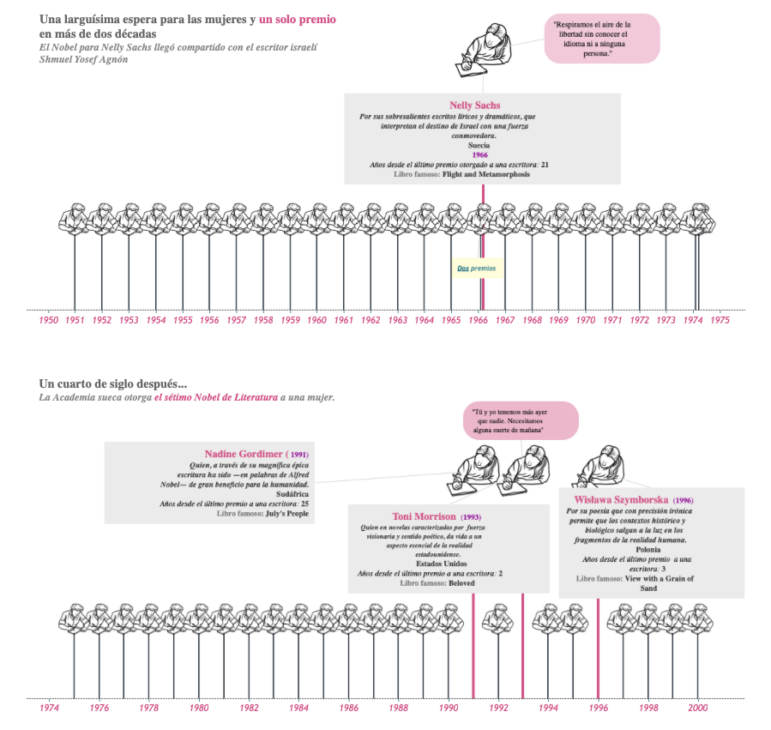
During the last half of the 20th century, only four women were awarded the Nobel Prize for Literature. Image: Screenshot, La Data Cuenta
On October 5, South Korean writer Han Kang became the first Asian woman to win the Nobel Prize in Literature. La Data Cuenta used data from the Swedish Academy, which awards the prize, to analyze the history of the award’s literary category. According to the special report, the award, which started in 1901, is marked by persistent gender inequality, with female writers repeatedly left in the shadow of their male colleagues. The outlet presents a timeline of the distribution of the awards, highlighting the times when women won the prize and including details about the trajectory and work of each one as well as how many years passed between women honorees, and highlighting the social dynamics and prejudices of each era. Among some highlights of the analysis: between 1946 and 1990, only one woman won, and half of the 18 recognitions for women — of the 118 granted to date — happened in the 21st century.
Young Britons Out of Work
The Financial Times sought to understand why the UK is experiencing such a steep rise in inactivity rates among young people. According to the report, the number of people not in education, employment, or seeking work has been rising much faster since 2022 among 16-24-year-olds than in the UK workforce as a whole. While, by contrast, the rates of young adults who are unemployed but actively seeking work have kept pace with the economy. According to the FT, this data would be correlated with the increase in claims for mental health benefits in the post-pandemic period, which has affected young people in the UK at much higher rates than in other developed economies. However, the report also showed that treating mental health alone may not be enough to change these numbers, since the majority of inactive young adults have few qualifications and there is a decline in low-skilled entry-level jobs, in addition to a widening educational gap between young men and women.
EU-Funded Immigration Detention Centers in Turkey
Over the past decade, millions of refugees have arrived in Europe from conflict zones or fleeing oppressive regimes. According to an investigation by Politico and eight other news outlets in partnership with Lighthouse Reports, because it considers it unsafe to deport Syrians and Afghans back to their home countries, the European Union spent more than €11 billion (US$12 billion) to help Turkey manage and house these refugees. Roughly €1 billion of that money went towards infrastructure such as detention centers, which are now being used by the country to round up and forcibly deport hundreds of thousands of Syrians, Afghans, and others. The reporting team interviewed 37 former detainees in these EU-funded centers, who described squalid conditions, and even torture and abuse — allegations Turkey denies. The report also claims that internal EU documents, civil society reports, diplomats, and officials have raised the issue with authorities but have been routinely ignored. One former officer even said: “They know. Everybody knows. People are closing their eyes.”
AMLO’s Mexican Presidency, by the Numbers
On September 30, Andrés Manuel López Obrador ended his term as Mexico’s president after six years in office, replaced by Claudia Sheinbaum, Mexico’s first woman elected to the position. At his inauguration in 2018, López Obrador made 100 commitments during his speech, which were monitored by Serendipia through a tool launched in early 2019. The outlet has published a final progress report with data from his six-year term. According to Serendipia, the former president leaves a legacy of social programs, unfinished projects, and “three numbers that grow every day: homicides, femicides, and disappearances.” There were 51 promises fulfilled, such as the reduction of salaries for senior officials and the sale of the presidential plane, and 19 broken, with special emphasis on the failure to resolve the case of the disappearance and murder of 43 students from Ayotzinapa, now almost 10 years ago. Bonus: just four days after the inauguration of the new president, the outlet published a new tool for evaluating the promises of the new Mexican head of state for the duration of her term.
Bonus: In Memoriam, Dennis Wong (1971-2024)
Losing a beloved colleague is not easy. But the South China Morning Post created a beautiful tribute to Dennis Wong — who worked for nearly a decade as a designer with the outlet’s infographics team — complete with a chart of his more than 150 awards, highlights of his work, and an overview of his professional career. Dennis was 53 years old and died in July after a year-long battle with cancer. Rest in peace, Dennis.



